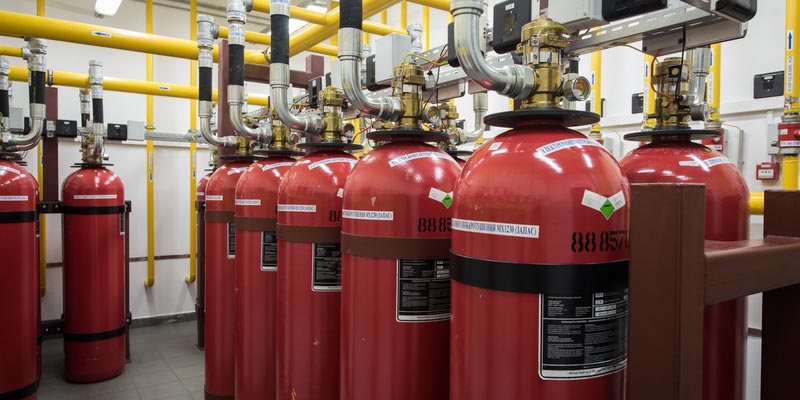Your server room equipment is expensive and loaded with valuable and p potentially irreplaceable data. The best way to protect your server room is to have the appropriate cooling measures installed. Your server room temperature should not fall below 50 degrees Fahrenheit and should not go over 82 degrees Fahrenheit. The best temperatures are between 68 and 71 degrees. Servers heat up very quickly and traditional air conditioning systems cannot typically keep the room cool enough. If electronics heat up too much they can combust and cause a fire.
The most common causes of server room fires include:
-Overheated electronics
-Electrical failure of your equipment
-Failure of subfloor wiring
-Fires that spread from other parts of the building
-It might come as a surprise, but even a wastebasket in a server room can catch fire and spread to the entire room.
A sprinkler system is the traditional fire suppression system installed in buildings, but if you dose your servers in water that could destroy them just like fire. That’s why alternative fire suppression measures are often installed in server rooms.
6 Tips For Server Room Fire Suppression
#1. Add Portable AC Units
There’s no point to install a fire suppression system if you do not plan on installing the right air conditioning systems. Even if you have a fully operative central air conditioner in your building that doesn’t mean it can keep up with your server room needs. This is especially true if the same thermometer is used for other parts of your building. The server room thermostat needs to be set lower than other parts of your building simply because the additional heat generated by a server room requires additional cooling needs. Adding a portable air conditioning unit to your server room will provide ample benefits, including protecting your server room from overheating.
We offer the latest selection of portable AC units for sale and for rent. We are more than happy to analyze your server room needs in order to match you with the perfect AC unit.
#2. Add Fire Suppression Systems
Gas fire suppression systems reduce oxygen levels to less than 15% by displacing oxygen with the introduction of argon/nitrogen. When oxygen levels remain below 15%, a fire cannot start because it doesn’t have the necessary oxygen levels. The system keeps oxygen levels above 12% in order to protect any humans that might be in the server room.
Synthetic gas suppression systems do not reduce oxygen levels, instead they use advanced cooling mechanisms to remove heat from the server room.
#3. Fire Detectors & Additional Fire Suppression Measures
You’ll also need to add additional fire suppression measures to your server room, such as:
-Smoke detectors
-Fire suppression control panel
-Loud alarm system
Early detection systems can also benefit your server room greatly by alerting you to a fire before it has a chance to spread or get out of control. Early detection systems including things like lasers, ionization or heat sensitivity detectors that can pinpoint very low levels of smoke. These measures help alert anyone in the building to the potential of fire in order to help stop it before it happens.
#4. Assess Your Server Room Fire Risk
Have a specialist come in to assess your risk for fires in your server room. There are often things that can float beneath the radar that are actually fire hazards.
#5. Use Flame-Resistant Panels To Create Protective Barriers
Create a protective barrier between other rooms and your server room: If there’s a fire in another room it can damage sensitive server room equipment even if the fire doesn’t spread into that room. By adding protective barriers around your server room you help protect it against indirect damage and also helps prevent spreading of flames. Lightweight and flame-resistant panels can be used to safeguard server rooms and archive rooms that are located within the building. Some panels can withstands temperatures up to 2,000 degrees Fahrenheit.
#6. Add Fire Stopping Intumescent Products
You can also add fire stopping intumescent products like caulks, sealants, sprays fire-rated roams, composite sheets, fire barrier pillows and cable transits. Any time you create a hole in the wall to run cable, ductwork or whatever else, building codes require the use of sealant to prevent spreading of flames from one room to another.

